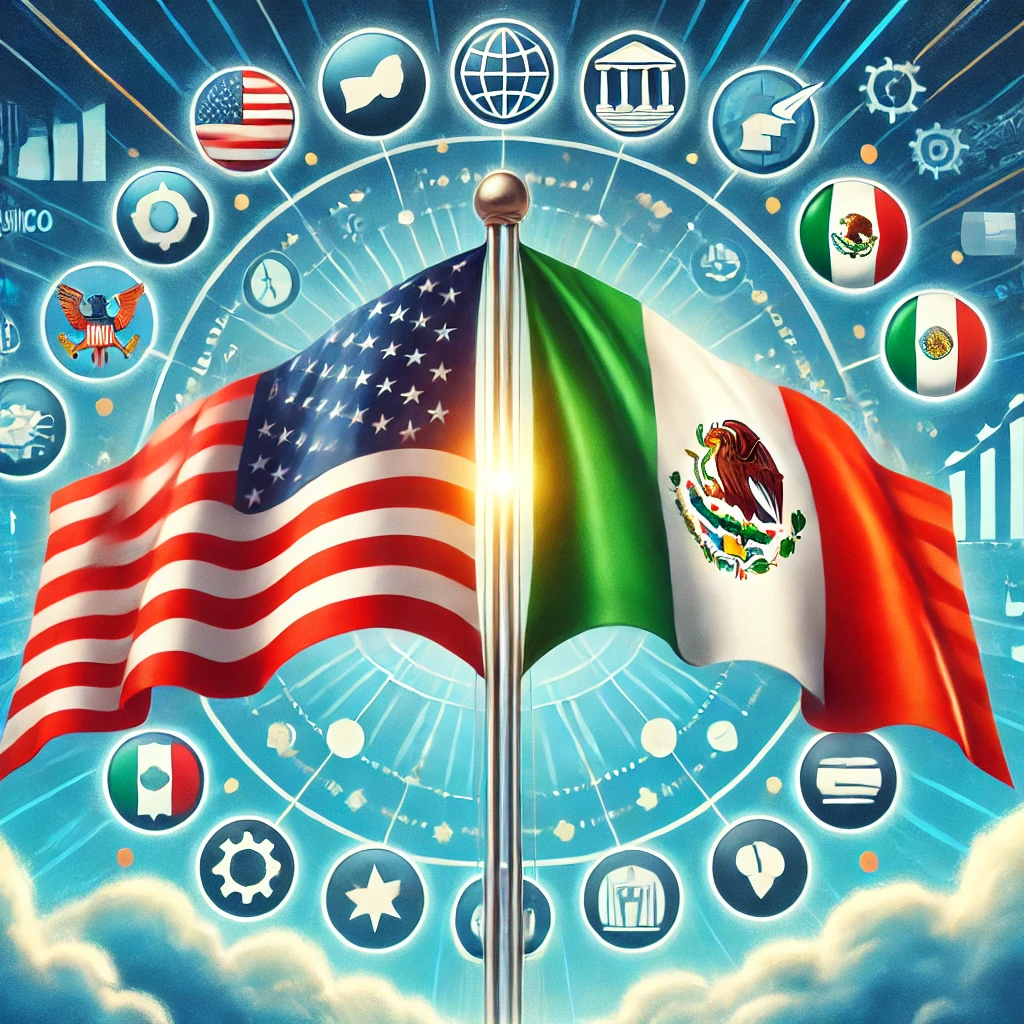
In late 2024, the U.S. economy was rocked by the reemergence of former President Donald Trump’s tariff threats targeting Mexico, sparking uncertainty in global markets. The potential of higher tariffs reignited trade tensions between the two nations, both of which are deeply intertwined in terms of economic activities, trade relations, and shared industries. As former President Trump’s rhetoric grew stronger, market reactions became swift, leading to sharp fluctuations in financial sectors, particularly affecting Mexico’s currency and stock markets.
For Mexico, a country heavily reliant on trade with the U.S., these developments threatened to disrupt years of hard-earned economic progress. The government of President Andrés Manuel López Obrador (AMLO) quickly moved to mitigate the damage, using diplomatic means and leveraging alternative trade strategies. This article takes an in-depth look at the trade dispute’s impact on the markets, the steps Mexico has taken in response, and the broader economic consequences of these tariff threats for both countries.
Historical Context of U.S.-Mexico Trade Relations
To fully understand the current trade tensions, it’s important to first consider the historical context of U.S.-Mexico relations. The trade relationship between the two countries has undergone significant transformations over the past few decades, particularly with the implementation of the North American Free Trade Agreement (NAFTA) in 1994. NAFTA eliminated most tariffs on goods traded between Canada, the U.S., and Mexico, creating a trilateral trade bloc that flourished through the late 20th and early 21st centuries.
However, in 2018, under President Trump’s administration, the U.S. renegotiated NAFTA, ultimately leading to the creation of the United States-Mexico-Canada Agreement (USMCA). The new agreement incorporated stricter provisions around labor rights, agriculture, and digital trade, reflecting Trump’s “America First” policies aimed at reducing trade deficits and bringing more manufacturing back to the U.S.
While the USMCA was seen as a modernized version of NAFTA, Trump’s approach to tariffs became a significant point of contention. Trump imposed steel and aluminum tariffs on Mexico, as well as tariffs on Chinese goods, which indirectly affected Mexico’s economy due to the disruption of global supply chains. The fallout from these policies laid the foundation for the current tariff dispute, as Trump has once again threatened to impose new tariffs on Mexican imports.
Trump’s Recent Tariff Threat
In November 2024, Donald Trump issued a series of statements threatening to impose tariffs on Mexican goods unless the country agreed to make certain concessions on trade, immigration, and drug control. The former president’s focus has increasingly shifted toward using economic pressure to address issues beyond traditional trade, including immigration policies and security concerns along the U.S.-Mexico border.
Trump’s proposed tariffs were sweeping, with estimates indicating that they could affect billions of dollars in trade. The automotive and agricultural sectors were particularly vulnerable, as they make up a significant portion of the bilateral trade between the two countries. Mexico is a top exporter of vehicles and auto parts to the U.S., while agricultural products like avocados, tomatoes, and tequila are staples in the Mexican export economy.
One of the key points of Trump’s tariff threats involved Mexico’s handling of immigration along its southern border, particularly with regard to the flow of migrants from Central America. Trump suggested that any failure to curb immigration and improve border security would result in escalating tariffs. This position left the Mexican government in a difficult position: balancing trade interests with diplomatic obligations to manage migration effectively.
Immediate Market Reactions
The immediate reaction to Trump’s tariff threat was felt in both U.S. and Mexican markets. Financial analysts noted that the uncertainty surrounding the tariffs created turbulence in foreign exchange markets, with the Mexican peso seeing significant fluctuations. As news of Trump’s proposals spread, the peso depreciated against the U.S. dollar, a clear indication of investor unease about the possibility of a new trade war. In addition, stock markets on both sides of the border experienced increased volatility, with shares of companies in the automotive, agriculture, and manufacturing sectors taking a hit.
For Mexico, the potential tariffs threatened to reverse years of economic recovery following the COVID-19 pandemic. Mexico’s economy, which has been slowly rebuilding after the global recession, is highly dependent on trade with the U.S. Any significant disruption to trade flows could exacerbate inflation, slow down the manufacturing sector, and lead to job losses in key industries.
On the U.S. side, companies reliant on Mexican imports expressed concerns over higher production costs and supply chain disruptions. Many U.S. manufacturers, particularly in the auto and electronics industries, rely on parts and materials sourced from Mexico. The potential for rising costs and supply shortages added an additional layer of anxiety to the markets.
Mexico’s Counteractions and Diplomatic Response
In response to Trump’s tariff threats, Mexico’s government, under President AMLO, adopted a diplomatic approach while also taking steps to protect its own interests. Mexico emphasized its commitment to the USMCA and reiterated its role as a strategic partner in the North American trade network.
The Mexican government initially sought to engage with U.S. officials diplomatically to avoid escalation. Mexican officials, including Foreign Minister Marcelo Ebrard, held talks with U.S. diplomats to address Trump’s concerns, particularly focusing on issues like border security and immigration control. While these discussions were taking place, AMLO also sought to solidify relationships with other international partners to cushion the impact of potential U.S. tariffs.
Simultaneously, Mexico began exploring alternative trade arrangements. AMLO’s government began discussions with other Latin American countries to form deeper economic ties, particularly with Brazil, Argentina, and Colombia, in order to diversify its trade portfolio. Mexico also turned to international bodies such as the World Trade Organization (WTO) to push back against what it viewed as unfair trade practices.
Another significant development was the push to strengthen Mexico’s domestic industries. Mexico’s government announced plans to provide tax incentives and support for small and medium-sized enterprises (SMEs) in sectors most affected by tariffs. The government also promised to work closely with Mexican businesses to ensure they could navigate the changing trade landscape effectively.
Economic Impact on Mexico
Should Trump’s tariffs be implemented, the economic impact on Mexico could be profound. Mexico’s economy is heavily reliant on its trade relationship with the U.S., particularly in sectors like manufacturing, agriculture, and services. A tariff increase could lead to higher production costs for many Mexican companies, particularly those in the automotive and electronics sectors. For instance, U.S. tariffs on automotive parts would increase the cost of vehicles manufactured in Mexico, making them less competitive in the global market.
The agricultural sector could also suffer under higher tariffs. Mexico is a significant exporter of produce, including avocados, berries, and tomatoes, many of which are sent to the U.S. market. Increased tariffs would make Mexican agricultural exports less attractive to American consumers, potentially leading to a decrease in demand.
In addition to sector-specific impacts, Mexico’s broader economy could be threatened by job losses. Mexico is home to a large manufacturing sector that is integrated into the global supply chain, especially in the automotive, aerospace, and electronics industries. A slowdown in these industries could lead to a rise in unemployment, particularly in border cities like Tijuana, Ciudad Juárez, and Monterrey, which depend heavily on trade with the U.S.
Impact on U.S.-Mexico Border Cities and Local Economies
The U.S.-Mexico border cities are uniquely positioned to feel the effects of tariff threats more intensely than other regions. These cities are economic hubs where cross-border trade is vital. For example, Tijuana in Mexico and San Diego in the U.S. share a symbiotic economic relationship, with goods flowing across the border every day. The potential of new tariffs could significantly disrupt this flow, leading to delays, higher costs, and reduced trade volumes.
Local businesses in these cities, many of which rely on importing materials and goods from the U.S. or exporting them in return, would face increased costs that could result in higher prices for consumers. In particular, industries like maquiladoras (factories in Mexico owned by U.S. firms) could see their costs rise, leading to lower profits and potential layoffs.
The Global Ripple Effect
Beyond the U.S. and Mexico, the ripple effects of these tariff threats extend globally. As one of the world’s largest trading nations, any disruption in U.S.-Mexico trade could have a domino effect on global supply chains. Countries that rely on imports from either the U.S. or Mexico could face increased costs, delays, and uncertainty in their own markets.
Moreover, the potential tariff escalation could contribute to broader economic instability, particularly in regions where both countries have significant trade partnerships. Countries in Asia, Europe, and South America that rely on goods manufactured in Mexico for their own supply chains could face increased production costs, which could be passed on to consumers worldwide.
The Long-Term Implications for U.S.-Mexico Trade
Looking ahead, the long-term implications of Trump’s tariff threat remain uncertain. If the tariffs are implemented, it could cause a sharp contraction in U.S.-Mexico trade, at least in the short term. However, both nations have historically found ways to resolve trade disputes, and the U.S. and Mexico share a long history of economic interdependence that is unlikely to disappear overnight.
The future of U.S.-Mexico relations will depend heavily on the political dynamics within both countries. While the Biden administration has generally taken a more diplomatic and cooperative approach to trade relations, the potential return of Trump to the political stage in 2024 could reignite the tariff disputes, especially if the political environment shifts again.
As the trade war rhetoric intensifies between the U.S. and Mexico, both nations stand to lose from the economic uncertainty created by Trump’s tariff threats. Mexico, which relies heavily on trade with its northern neighbor, must navigate these turbulent waters carefully. While diplomatic efforts continue, both governments must find ways to mitigate the long-term impacts on their economies and their citizens.
In the end, the path forward will depend on the ability of both sides to find common ground on trade, immigration, and border security. As 2024 progresses, the world will be watching closely to see how this latest chapter in U.S.-Mexico relations unfolds, and what the consequences will be for global trade and economic stability.
Visit our other website: https://synergypublish.com


